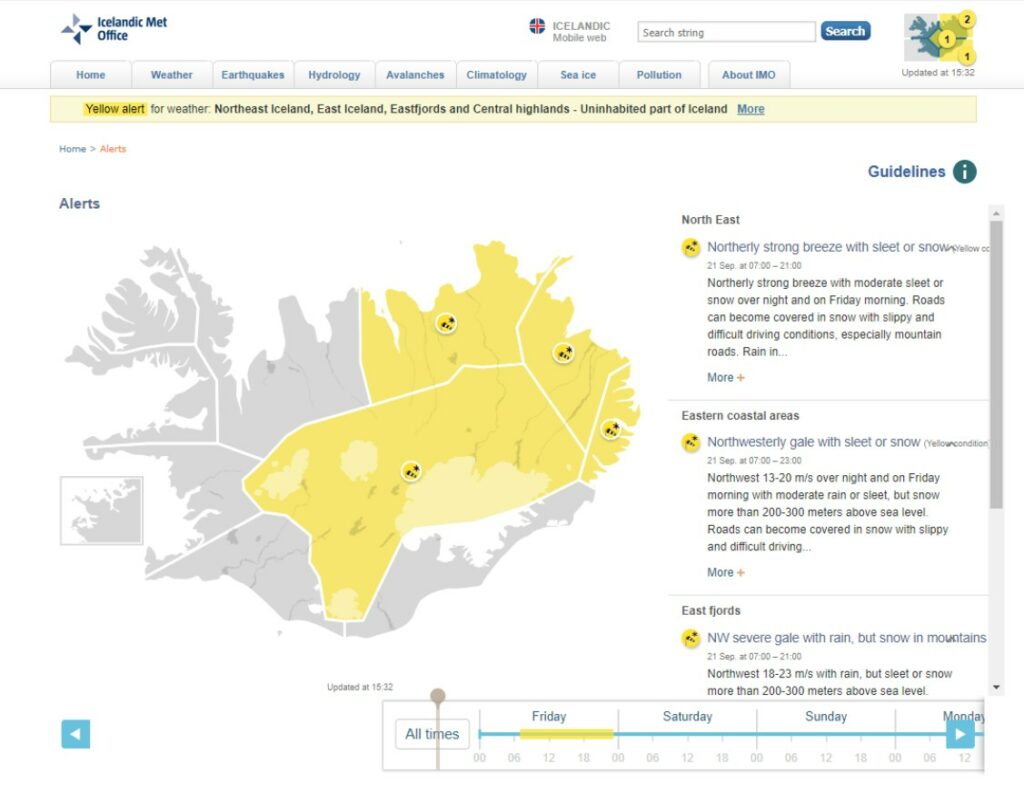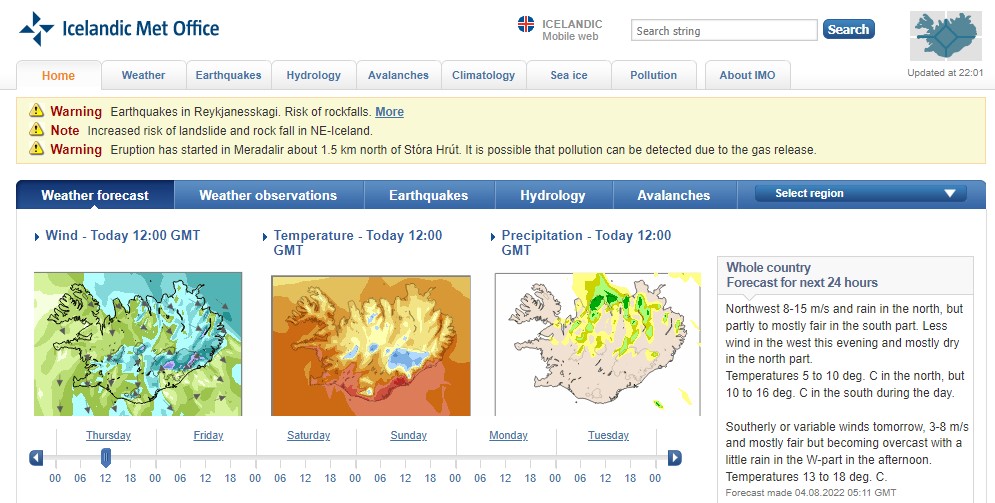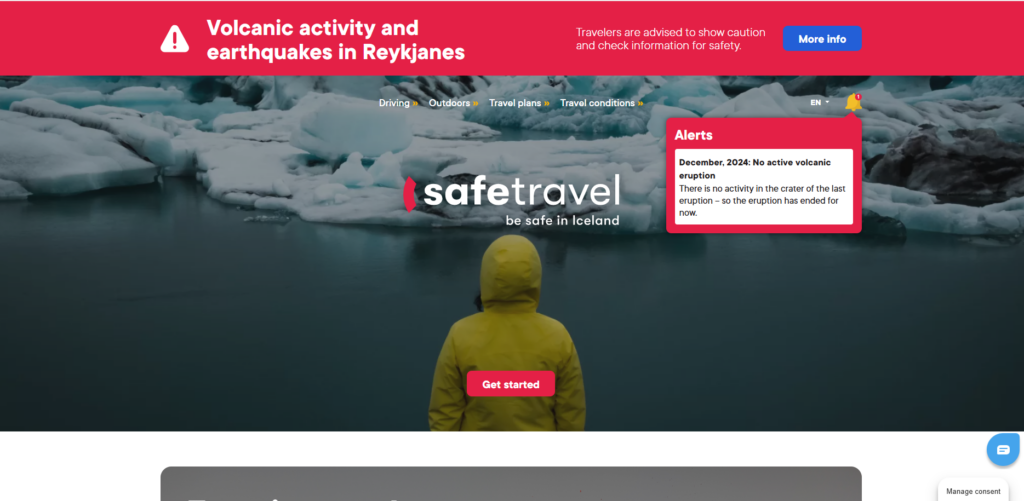Safe travelling
The website safetravel.is provides access to important travel information with the aim of increasing safety awareness of tourists in Iceland.
Travellers are highly recommended to submit a travel plan on safetravel.is simplifying the process of locating them in case of an emergency.
In case of an emergency call 112. If you accidentally dial 911 you will be automatically redirected to 112.

Safety issues
Driving in Iceland
When travelling by car in Iceland one must familiarize themselves with traffic rules and regularly check the road conditions.
To check the road conditions and closures on this interactive map at umferdin.is. Alternatively, you can also call the Icelandic Road Administration (phone: 1777) during weekdays.
About driving in Iceland
Traffic rules
Top 12 tips for driving in Iceland from safetravel.is
Road signs
Icelandic Road signs from safetravel.is
Ultimate guide to Road signs in Iceland from Iceland Car Rental
Speed limits
Within populated areas: 50 km/h (30 mph)
In rural areas – gravel roads: 80 km/h (50 mph)
In rural areas – asphalt roads: 90 km/h (55 mph)
Be alert.. watch the signs!
Drivers must pay attention when encountering:
Sheep on the road: If drivers encounter sheep on the road, they must slow down and gently honk the horn as this will alert the sheep to run to the side of the road. If they notice that a sheep is on one side of the road and a lamb on the other side, they should expect that the sheep or the lamb will run to the other side. If a driver hits a sheep, they must call 112. Drivers can be held liable for hitting sheep.
Single-lane bridges: Single-lane bridges must be approached slowly and with caution. The general rule is that the car closer to the bridge has the right of way. After that, vehicles on each side take turns crossing. Have a look at this video to familiarize yourself with single-lane bridge safety.
Tunnels: There are currently 14 open road tunnels in Iceland. Tunnels are usually build under mountains to prevent winter isolation of remote communities which would otherwise have to depend on high roads that are often closed due to snow, to shorten distances between communities, and to increase road safety by bypassing dangerous stretches of road. Hvalfjörður Tunnel, is a tunnel under a fjord, and is among the longest underwater roads in the world. Learn more about tunnels and road safety in tunnels by clicking here.
Single-lane tunnels: Single-lane tunnels in Iceland have frequent passing places, where vehicles pull over to allow oncoming traffic to pass. Passing places are usually spaced around every 100-150 meters, allowing drivers to pull to the side when they encounter an approaching vehicle. In single-lane tunnels, right-of-way rules are very specific. The vehicle closest to a passing place , on your side (right side of the road), is required to stop to let the oncoming vehicle pass. In many cases, signage or lights at the tunnel’s entrance will indicate right-of-way and give instructions for drivers.
Due to the narrow space and possible oncoming traffic, speed limits are strictly enforced, and drivers must go slowly. Some of these tunnels are equipped with good lighting, but visibility can still be challenging. Drivers should enter slowly, keep their headlights on, and be prepared to yield.
Driving in the Central Highlands
Roads in the Central Highlands are called F-roads (i. fjallvegir). F-roads are mountain and gravel roads only accessible for 4×4 (AWD) vehicles. F-roads are difficult to drive as the terrain is rough, and the roads often have potholes meaning it takes a long time to drive them.
It is important to plan a route in advance and know how long it will take. Keep in mind the average speed for cars on F-roads is rarely over 40km/hr.
Before driving on F-roads, tourists must always check the conditions of their rental car agreement to see whether they are allowed to drive on F-roads or not.
During winter, the Icelandic Highlands are impassable. Most of the roads open between late May and late June (depending on the weather).
Once the roads are open in summer, driving in the Highland requires experience in addition to a proper vehicle (AWD vehicle with good ground clearance).
Many roads in the Central Highlands have river crossings. If the driver does not know how to cross a river, they should turn around and not attempt to cross the river. No insurance covers the damaged caused by river crossings.
If an emergency occurs while driving on an F-road, call 112 for Iceland’s emergency services. Off-road driving is forbidden in Iceland due to safety and nature preservation factors. Always follow marked roads and pay attention to any posted warnings or road signs. Keep a charged phone in the car at all times in order to call for help if needed.
Make sure to check out the Highland Driving information from safetravel
| Popular F-roads (road number) | Opening date earliest | Opening date latest |
| Kjölur (35) | May 24th | June 15th |
| Sprengisandur (F26) | June 20th | July 9th |
| Landmannaleið via Dómadalur (F225) | May 28th | July 14th |
| Sigalda towards Landmannalaugar (F208) | May 24th | June 20th |
| Other F-roads | see here |
Weather and safety
Weather warnings
The weather in Iceland can change rapidly meaning it is very important to be alert and check the weather forecast before and while travelling. Wind and more specifically, wind gusts can be particularly dangerous. Read more about weather in Iceland here. For easily accessible information about wind gusts check out the wet.is website.
In case of extreme weather, the Icelandic Meteorological Office (vedur.is) issues weather warnings according to a four-colour system (green, yellow, orange and red), with red indicating the most extreme weather which can cause hazardous conditions and high societal impacts.
Weather alerts are announced on vedur.is in a yellow box/banner and in the top right corner of the screen.
By clicking on the alert you are directed to specific and detailed information about the weather warning, including what type of weather is expected, how long the extreme weather is supposed to last and what regions will be affected.

Staying warm
Regardless of the weather, it is always important to dress appropriately. Travellers should always have with them several layers of clothing and ensure that they have warm, windproof and waterproof clothing as well as sturdy shoes.
Tourists often underestimate the combined effect of wind, rain and cold temperatures. Check out the instructions for appropriate clothing on safetravel.is.
For those who want to rent outdoor clothing, we recommen IcelandCover, outdoor clothing rental
Natural disasters
There are various natural disasters (e.g. earthquakes, volcanic eruptions, glacial outburst floods, storms, and avalanches) which can occur in Iceland.
When there are warnings for potential natural disasters they are posted within a yellow banner across the front page of vedur.is . On the safetravel website there is a red banner as well as on safetravel.is.
When such warnings are issued, it is important to communicate them to travellers and encourage them to stay safe and alert.
The Department of Civil Protection and Emergency Management (i. Almannavarnir) is responsible for daily administration of Civil Protection matters and informs the public of what to do in case of an emergency.
Click here to find information on how to prepare for, prevent and respond to various disasters.


ICE-SAR
The ICE-SAR (Icelandic Association for search and rescue) consists of thousands of volunteers and specialists which help inhabitants as well as travelers in dangerous situations on land and sea. Assistance in case of an emergency is free of charge. However, if travellers disobey rules or find themselves in trouble due to negligence they might receive fines and be charged for the assistance.
Health care
Health care is available throughout the country at health care centres (i. heilsugæsla) and hospitals (i. spítala) . People are encouraged only to got to a hospital in emergency situations. Health care centre’s have scheduled opening hours for same-day appointments. Click here for an interactive map where you can access information about locations of health care canters, opening hours, and emergency services across all Iceland.
The Information Centre for Health Care in the Capital Area(HH) offer medical consultations via phone around the clock and on site services outside working hours on week days in addition to weekends and all public holidays. Access to the online chat of the healthcare center is on Heilsuvera . Phone: 1700
Health insurance: The Icelandic healthcare system uses a co-payment system which reduces costs for people who frequently need to access healthcare. Citizens from EU and EEA/EFTA countries must have their European Health Insurance Card (EHIC) to avoid being charged in full. Travel insurance is advised for all non-EEA/EFTA visitors if medical attention is needed. Note that without insurance papers travellers will pay full cost for services.
Medicine is obtained at pharmacies (i. apótek) which are widely accessible during normal business hours.
Click here for more information about health care in Iceland.
Other safety issues
Sneaker waves: are a natural phenomenon which happen at the Reynisfjara beach due to strong currents and the underground cliff just offshore, which adds to the pulling effect of the wave. which can result in sneaker waves. The waves are so powerful that they can sweep people into the ocean when coming too close. There is a warning sign with flashing light indicators that indicate hazard levels from low (green) to high or extreme hazard (red). Check out more about safety and sneaker waves here.
Geothermal areas: The heat levels at geothermal active areas is often around 100°C (212 Fahrenheit) meaning it is important for tourists to avoid contact with the hot water or the sulphurous mud pools, a person could suffer serious burns. Meaning it is hazardous to leave the path in these areas.
Slippery trails: Walking paths and trails can be slippery when wet so walk with caution when trails are wet. And during winter, trails are often icy, in particular near waterfalls. Therefore, it is recommended to use ice cleats or ice grips.
Volcanic activity: Generally speaking volcanic activity is limited to specific areas and are rarely any threat to the general public. Iceland’s authorities are dedicated to researching and constantly monitoring volcanoes making it one of the safest countries when it comes to volcanoes. It is however very important to monitor and mind any and all alerts and instructions from the Icelandic Meteorological Office. The best way to ensure safety is to recommend a local licensed guide.
Travellers must follow the instructions on warning signs and respect rails and fences , they are there for a reason.
